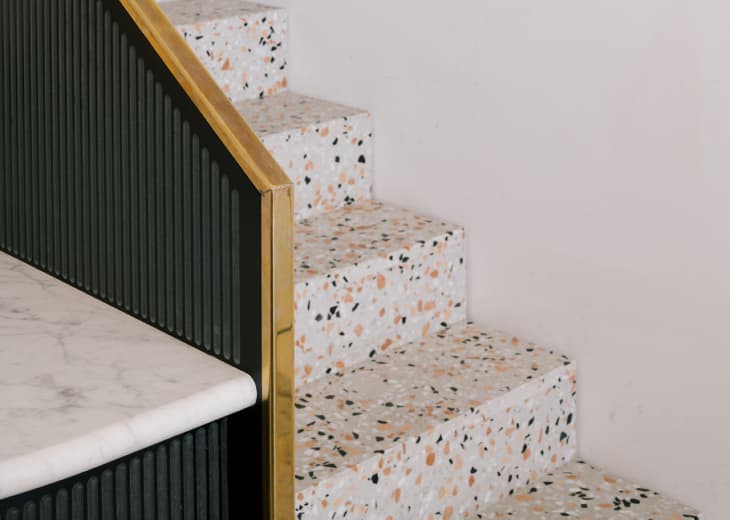Terrazzo: The Forgotten Flooring Material is Back, and Better than Ever

The wheel of design is always turning, and at no time is this more delightful than when something you remember from your childhood as being particularly dowdy is suddenly the height of chic. My mother’s sandals and culottes are suddenly for sale at Urban Outfitters, and similarly, the floors of my parents’ house are the hottest new thing in design. Ladies and gentlemen, say hello to terrazzo.
You probably remember this stuff from the floors of a school or government building conceived sometime in the 70s. It’s a very hard, stone-like material, with those telltale chips embedded in the matrix. Terrazzo actually has a very long history — examples have been found as far back as 9,000 B.C.
It’s currently viewed as a bit of a luxury finish, but modern terrazzo was actually created as a budget-friendly, DIY material. Venetian construction workers, looking for a low-cost way to surface the terraces surrounding their homes, set broken bits of marble into clay, and then ground down the resulting surface with stones until it was smooth. The name they gave this finish — terrazzo — is also the Italian word for terrace.
These days terrazzo is made with chips of marble, quartz, granite, or even glass set into a matrix of concrete or epoxy resin. The chips can actually be quite large, and the matrix and the aggregate can be almost any color you can imagine, which makes for a myriad of design possibilities.
Here’s a detail of a coffee table with a terrazzo top inlaid with marble, quartz, and granite. In this case, the pieces of stone laid into the concrete are quite large, producing a patchwork effect. Image from Modern Times.
Dzek makes a proprietary terrazzo (or ‘engineered marble’) that they call Marmoreal. It comes in white and black varieties, and each one is particularly striking, with oversized chips of Italian marble in a variety of bold colors. It looks a bit like granite on steroids, and it is certainly not a surface for the faint of heart.
Advances in the engineering of terrazzo mean it’s no longer limited to floors or walls: since Marmoreal is pre-cast, it can be used for countertops as well.
The terrazzo you remember from the 70s might have been a bit drab in its palette, but the medium presents a lot of possibilities for color. Take, for example, this colorful terrazzo by Shiro Kuramata, used for the Kyoto table he designed for Ettore Sottsass’s Memphis collective. Image from Skinny laMinx.
The Kyoto table retails for €5,929.20, but if you want to bring home some colorful terrazzo, Anthropologie sells a version that’s now on sale for $550.
Pink granite laid in a pink matrix makes for a totally unique countertop material in this kitchen from Miss Moss.
If you love the look of terrazzo but aren’t quite committed to remodeling, fortunately there are quite a few wallpapers that imitate the look. This paper from Fleux is available with a blue, rose, or white background.
In this ‘Holy Granit’ paper from Photowall, the ‘aggregate’ appears to contain tiny chips of its own.
This wallpaper from Papermint makes for a softer look, with chips in subdued pastel colors.
From Divisare, another instance of rather large pieces of stone being used as aggregate in a terrazzo application, this time a floor. Here, there are smaller pieces mixed into the cracks between the larger ones.
This countertop from Joli Place combines stone aggregate with metal accents.
Terrazzo on a wall (and paired with a black lacquered cabinet) makes for a luxe look in this interior from The Socialite Family.
Re-edited from a post originally published 3.13.17